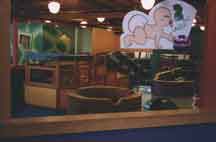Designing Safe Play Environments for Children
Designing safe play environments for children entails four different types of safety - personal injury, sanitation, security and toxicity.
Personal Injury
While designing for safe children's play is
essential, there is a difference between hazards and risk. Safety concerns should not
compromise play value. The play environment  needs to offer children both
challenges and safe risks. Play environments that are too safe are not just boring, but
children will often find ways to take risks and find challenges, often in ways that are
hazardous. A quality play environment is both safe and challenging.
needs to offer children both
challenges and safe risks. Play environments that are too safe are not just boring, but
children will often find ways to take risks and find challenges, often in ways that are
hazardous. A quality play environment is both safe and challenging.
According to the Consumer Product Safety Commission, nearly 200,000 playground-related injuries require emergency room visits each year. The safety issues that relate to outdoor playgrounds are just as relevant for indoor children's play areas. Factors that affect safety from physical injury include:
Equipment Design
There are two national standards for the design of play equipment:
- "Playground Equipment Safety Guidelines" by the U.S. Consumer Product Safety Commission (CPSC),
- "Consumer Safety Performance Specifications for Playground Equipment for Public Use" by the American Society For Testing And Materials (ASTM).
ASTM is currently in the process of finalizing special safety and accessibility standards for soft contained play equipment.
Fall Zone Surfacing
The leading and most serious injuries are caused by falls to the surface. Shock absorbing surfaces can help cushion falls and prevent serious injury. The CPSC guidelines include standards for safety surfacing and fall zones.
Age Appropriate Equipment
Children are developmentally different. Equipment needs to be designed for the age of the child. What is appropriate for an 8 year old is too big and could be dangerous for a 3 year old. The converse is also true. Most injuries related to age inappropriateness involve children four and younger playing on equipment designed for older children. Often, the solution is to design separate areas for infants and toddlers, 3-5/6's and 6-10's.
Supervision
Children's play areas and equipment needs to be designed based upon the amount of adult supervision there will be. Activities that are safe when supervised can be extremely hazardous if unsupervised.
Sanitation
Wherever children gather, diseases, lice and other medical problems can be quickly spread. All play areas need to be designed for easy cleaning and sanitation. Just as important, there need to be procedures to assure the cleaning occurs on a scheduled basis.
Areas for infants and toddlers are especially prone to the spread of diseases. At that age, the child will place everything in their mouth. These areas need to be designed to be cleaned with bleach solution daily at a minimum. Play objects need to be sanitized after use by each child.
Security
In today's society, parents are especially afraid that their children may be kidnapped or abused by a stranger. This "Boogie Man" syndrome makes parents were wary and anxious about taking their children to public places. To have parents feel comfortable requires, at a minimum, that the play area be enclosed with good visibility throughout. Many facilities go further and use a wrist-banded entry system to assure that children only leave with the adults they came with.
Toxicity
Toxicity, health risks and other standards for art, craft and other creative supplies have been established by The Art & Creative Materials Institute, Inc. (ACMI) and labeling standards for the materials established by the chronic hazard labeling standard, ASTM D 4236 and the U.S. Labeling of Hazardous Art Materials Act (LHAMA). Only materials that bear the ACMI Non-Toxic Seals should be purchased for use by children. ACMI has certified over 60,000 art, craft and other creative materials.


